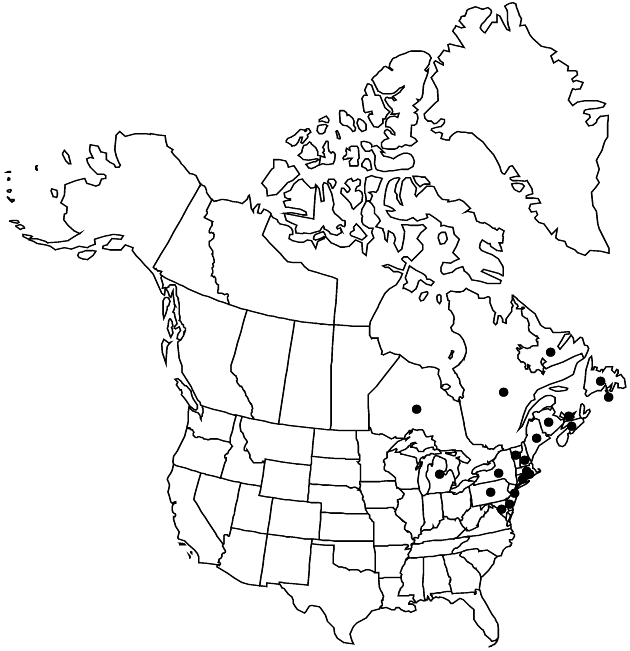Oclemena nemoralis
Leafl. Bot. Observ. Crit. 1: 5. 1903.
Plants 5–70 (–90) cm (± loosely clonal, sometimes clustered; rhizomes subsuperficial, elongate, herbaceous or woody, slender, sometimes branched). Stems 1, erect, thin (1–2 mm diam.), straight, sparsely strigillose. Leaves 30–100+, crowded, proximal sometimes withering by flowering; sessile; blades linear to linear-lanceolate, 10–60 × 1–8 mm, bases rounded, margins recurved, appearing entire but remotely serrulate, scabrous, teeth minute, apices obtuse to acute, abaxial faces sparsely hispid, densely stipitate-glandular, adaxial scabrous; distal slightly reduced, rapidly becoming bracts in arrays. Heads 1–15+, usually borne singly, sometimes in loose corymbiform arrays, branches ascending, at acute angles with stems. Peduncles filiform, 3–7 cm, ± strigillose, eglandular; bracts 3–8, small, linear, scabrous. Involucres (5–) 6–7.5 mm. Phyllaries lance-linear to linear, margins often pinkish distally, sparsely to moderately strigillose, sometimes sparsely glandular. Ray-florets 13–25; corollas pale to deep pink, seldom white, 11–18 × 1.2–2.6 mm. Disc-florets 20–35; corollas abruptly ampliate, 5–7.5 mm, glabrous; tubes shorter than or equal to tubular throats, glabrous, lobes erect, triangular, 0.5–1 mm. Cypselae tan, fusiform-obconic, ± compressed, 1.9–3 mm, ribs 5–8 (paler than bodies), faces sparsely strigillose or glabrous, gland-dotted; pappi of yellowish or pale salmon-colored bristles in 2 (–3) series, ± equal to disc corollas (outer shorter and very sparse, innermost apically attenuate). 2n = 18.
Phenology: Flowering summer–early fall.
Habitat: Sphagnum bogs and very poor fens, edges of floating bogs, damp sandy shores, acidic or peaty lakeshores, pond margins, cracks in acidic, barren rocks in perhumid areas (Nfld.)
Elevation: 0–900 m
Distribution

St. Pierre and Miquelon, N.B., Nfld. and Labr., N.S., Ont., P.E.I., Que., Conn., Del., Maine, Md., Mass., Mich., N.H., N.J., N.Y., Pa., R.I., Vt.
Discussion
Oclemena nemoralis is known only from boreal, northeastern North America, reaching its western limit in the eastern Lake Superior area. It is considered extirpated from Delaware and is endangered in Connecticut and Pennsylvania. It is adapted mainly to acidic Sphagnum bogs and is a wetland indicator. Its small, ericoid, crowded leaves suggest adaptation to open, nutritionally-deficient habitats. The ecogeography and autecology of this species was discussed by L. Brouillet and J.-P. Simon (1979, 1980, 1981). D. E. Moerman (1998) reported that the Chippewa used a decoction of the root (probably rhizome) as drops or on a compress for sore ear. Occasional white-rayed clones occur within O. nemoralis; those have been named Aster nemoralis forma albiflorus Fernald, forma nemoralis designating the more common pink variant. White variants also may represent introgressive clones in areas of hybridization with O. acuminata (see under O. ×blakei).
Selected References
None.
Lower Taxa
"[" is not declared as a valid unit of measurement for this property."]" is not declared as a valid unit of measurement for this property.